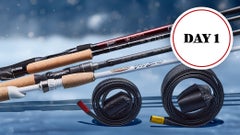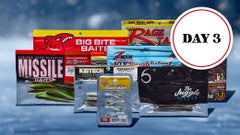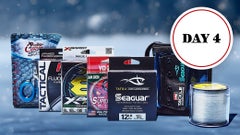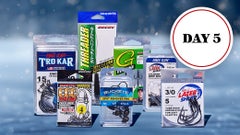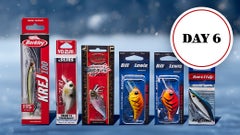Summer Night Crankbait Patterns & Techniques
When the sun goes down bass will rely much more on their lateral lines to locate prey, so you need a bait that they can feel to make it easy for them to find. Crankbaits are a great choice as they move a lot of water and draw fish from long distances with their hard thumping action and loud rattles. Focus on fishing the best-looking hard cover locations where the biggest fish in the lake live, but are just too smart to bite during the day. These fish want to eat after the sun goes down so slow down and target all the obvious steep rocky banks, bluff walls, dams, rocky main lake points, boulders, and wood when cranking after dark.
Rods:
During the summer large groups of fish will position both shallow and deep at night, and how they set up will vary from one body of water to the next. Use the wide wobbling action of a crankbait to fire up the school off deep points and ledges. For your medium to deep diving crankbaits, a Medium Heavy to Heavy power rod in the 7’4” – 8’ range is ideal. When targeting shallow cover, try using a square bill and look for a short, powerful cranking rod with Medium Heavy to Heavy power in the 7’ – 7’2” range. No matter what type of crankbait you are throwing, you are going to want the forgiving, parabolic bend of a Moderate or Moderate Fast taper to absorb headshakes and keep your treble hooks pinned.
Reels:
Warmer water temperatures will keep the fish active after dark, but you may have to vary your retrieve to dial in the correct speed for a particular evening. Once the sun goes down, try using a slow retrieve and fishing your cranking areas methodically to help the fish better track down your bait. A 200-size casting reel with a deep spool will provide plenty of line capacity and help improve your casting distance so you can keep your crankbait in the strike zone longer. Whether you are targeting fish in shallow or deep water, a casting reel in a mid-range 6:1 – 7:1 gear ratio will let you stay efficient and still cover plenty of water.
Line:
Disguising your line is less critical at night, so some anglers will look for the added power and increased response from no-stretch braided fishing lines. Depending on the size of your crankbait, try using braided line in the 30-50lb range. Tying direct to braid provides tons of feel on your shallow running squarebills and offers quality abrasion resistance as your crankbait grinds the bottom and deflects off cover. Any fluorocarbon in the 12-15lb range that you would typically use during the day will work just fine for night cranking. Consider bumping up your line rating to avoid constantly having to re-tie, as you are far more likely to cast over snags or at targets that could damage your line when fishing at night.
Modifications & Rigging:
Swapping your treble hooks out is always a good idea when you are cranking. Crankbaits are most effective when they are deflected off rock, wood, and hard cover, so it’s more important to inspect the sharpness of the hook points and swap them out as they dull. When fishing at night with deep or medium diving crankbaits, remember to keep some Suspendots or Suspendstrips handy, so you can change the buoyancy of your crankbait if the fish are suspending off the bottom.
Tips & Tricks:
Experiment with retrieves when fishing at night. Your goal is to get the fish to feel the sound and thumping action of your crankbait. Try slowing things down and creeping the crankbait along with short turns of the handle as soon as you contact bottom, or fish the crank aggressively by burning it back using a rapid stop and go retrieve.
Also, fishing with treble hooks at night can be very dangerous, so be careful when you are slinging your crankbait around at night. It’s very important to be highly aware of boat positioning and where your co-angler is fishing off the back of the boat to minimize the chances of hooking your buddy.
Colors:
Solid colors, usually anything very light or dark colored, like white or black variations, work the best at night. Vibration and thump are the main ingredients that dictate nighttime attraction, so color selection becomes far less important than when there is some light penetrating the water column. That being said, solid colors at night do help create a silhouette for your bait and help fish track it down a little better.















































